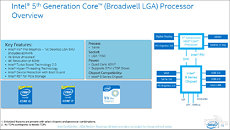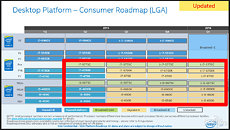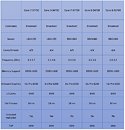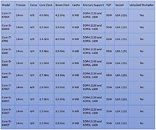Tuesday, May 5th 2015

Desktop OEMs Begin Listing "Broadwell" Chips, "Skylake" Arrives in Q3
Major pre-built desktop manufacturers began listing products driven by 5th generation Core "Broadwell" processors, which are having a brief stint at the markets before being replaced by 6th generation Core "Skylake" processors in Q3-2015. The 5th Generation Core family is led by two parts, the Core i5-5675C, and the Core i7-5775C, both of which come with unlocked base-clock multipliers, are based on Intel's new 14 nanometer silicon fab process, and built in the LGA1150 package, compatible with existing Intel 9-series chipset based motherboards, with BIOS updates.
The Core i5-5675C and i7-5775C aren't exactly successors of the i5-4690K and i7-4790K. The i7-5775C is placed in a product tier Intel calls "P1+," while the i5-5675C is placed in one called "MS2+." The two aren't exactly in the same plane as P1K (eg: i7-4790K) or MS2K (eg: i5-4690K), respectively, and don't qualify as P1 (eg: i7-4790 non-K) or MS2 (eg: i5-4690 non-K). The two still feature unlocked multipliers. This places them somewhere between P1K/MS2K and P1/MS2. Both the i5-5675C and i7-5775C are quad-core chips, and physically feature just 6 MB of L3 cache. The i7-5775C has access to all 6 MB of it, while the i5-5675K features just 4 MB.Since "Broadwell" is an optical shrink of "Haswell" to 14 nm (à la "Ivy Bridge" being a 22 nm shrink of the 32 nm "Sandy Bridge"), it pays heavy dividends with energy efficiency. The two chips offer rated TDP of just 65W. Perhaps the biggest change between Broadwell and Haswell is the presence of a 128 MB eDRAM L4 cache for the Iris Pro 6200 series integrated graphics to use as a really quick scratchpad. The iGPU uses both this 128 MB cache, and the system memory for graphics, juggling hot data into the cache, and keeping less frequently accessed data into the system memory. The Iris Pro 6200 features 48 execution units, and supports DirectX 11.2.Intel's big graphics push is driven not by its ambitions to eat into big-ticket PC gaming, but by two market forces
In addition to the Z170 Express chipset, PC enthusiasts should look out for two processors in particular - the Core i7-6700K and the Core i5-6600K. The two are the true successors to the i7-4790K and i5-4690K, occupying Intel's P1K and MS2K product tiers, respectively. The i7-6700K offers 4.00 GHz core clocks, with 4.20 GHz Turbo Boost, 8 MB of L3 cache, and HyperThreading. The i5-6600K, on the other hand, feature 3.60 GHz clocks, with 3.90 GHz Turbo Boost, 6 MB of L3 cache, but lacks HyperThreading. Both these chips feature TDP ratings of 95W.
Sources:
PCOnline.com.cn, Many Thanks to qubit for the tip.
The Core i5-5675C and i7-5775C aren't exactly successors of the i5-4690K and i7-4790K. The i7-5775C is placed in a product tier Intel calls "P1+," while the i5-5675C is placed in one called "MS2+." The two aren't exactly in the same plane as P1K (eg: i7-4790K) or MS2K (eg: i5-4690K), respectively, and don't qualify as P1 (eg: i7-4790 non-K) or MS2 (eg: i5-4690 non-K). The two still feature unlocked multipliers. This places them somewhere between P1K/MS2K and P1/MS2. Both the i5-5675C and i7-5775C are quad-core chips, and physically feature just 6 MB of L3 cache. The i7-5775C has access to all 6 MB of it, while the i5-5675K features just 4 MB.Since "Broadwell" is an optical shrink of "Haswell" to 14 nm (à la "Ivy Bridge" being a 22 nm shrink of the 32 nm "Sandy Bridge"), it pays heavy dividends with energy efficiency. The two chips offer rated TDP of just 65W. Perhaps the biggest change between Broadwell and Haswell is the presence of a 128 MB eDRAM L4 cache for the Iris Pro 6200 series integrated graphics to use as a really quick scratchpad. The iGPU uses both this 128 MB cache, and the system memory for graphics, juggling hot data into the cache, and keeping less frequently accessed data into the system memory. The Iris Pro 6200 features 48 execution units, and supports DirectX 11.2.Intel's big graphics push is driven not by its ambitions to eat into big-ticket PC gaming, but by two market forces
- The influx of high-resolution displays such as 4K (3840 x 2160 px) and 5K (5120 x 2880 px), which are being shrunk down in panel size and used to present high-DPI display-heads;
- MOBA games such as "League of Legends," which is a rare combination of low system requirements and high popularity that can be monetized in gaming tournaments and streaming
In addition to the Z170 Express chipset, PC enthusiasts should look out for two processors in particular - the Core i7-6700K and the Core i5-6600K. The two are the true successors to the i7-4790K and i5-4690K, occupying Intel's P1K and MS2K product tiers, respectively. The i7-6700K offers 4.00 GHz core clocks, with 4.20 GHz Turbo Boost, 8 MB of L3 cache, and HyperThreading. The i5-6600K, on the other hand, feature 3.60 GHz clocks, with 3.90 GHz Turbo Boost, 6 MB of L3 cache, but lacks HyperThreading. Both these chips feature TDP ratings of 95W.




20 Comments on Desktop OEMs Begin Listing "Broadwell" Chips, "Skylake" Arrives in Q3
Does Intel intend to have Broadwell competing against both Haswell, then Skylake? I'm confused. I get the whole enthusiasts being 2 generations behind (5xxx series being Haswell, and competing against Skylake offerings is... I'll just let that go) but what exactly is Broadwell doing?
I get it being both LGA and BGA on the packaging, but that doesn't allow me to understand the 3 month exclusivity.
Can someone explain this? I'm so confused. You'd think if Intel was absolutely dead set on just keeping their market share they wouldn't bother with Skylake until next year, once the Broadwell chips had sold to everybody without self control.
Also, what the heck is up with the memory? Intel must be seeing some issues with DDR4 supply if they go whole hog in the enthusiast market, but half way with their mainstream offering. I just can't understand what logic compels this roadmap.
In my opinion it's where it needs to be.
Side note: My MBP with a i7-4770MQ with the Iris Pro in it and while I never game on it, I can say that it handles 4k video flawlessly.
duh intel learn, kick the IGP out of the high end (i5/i7) pretty please ... that thing serve nothing in that range and just add more tdp to the package ... (IMHO)
altho a good thing will be if the 4790K lower price ... or 2nd hand, tho a 4690K is enough i would not spit on a 4790K either way ... :roll:
Because there is a lot of DDR3 chips lying around by memory makers and Intel does not want to disappoint them by using only DDR4 chips. In other words Intel does not support technological advancement (there is an irony here since DDR4 does not have any major technological advancement which would warrant an upgrade from DDR3) in favor of friendly relations with companies.
I myself like the idea that I can use my old DDR3 RAM since it is enough fast but they decided to use controller which will support DDR3 and DDR4 from the wrong reasons.
Personally I would rather see faster iGPUs, not just simply removing them. Also, your TDP argument is flawed because Intel power gates the iGPU when it's not in use. If I had the performance of my 6870s in crossfire in an iGPU, I would take it in a heartbeat over discrete graphics.It's a really good way to transition from one to the other. It lets the DDR3 stock get used up while at the same time DDR4 inventory grows. I personally see it being a good plan, much like how AM3 CPUs were with DDR2 to DDR3.
i also would like a stronger IGP, in chip that are meant to have a IGP ... i don't get why people would like a i5 or i7 with a strong IGP ... but most use who get those chips use discrete graphics ... let say it's a waste of silicon to have a igp in the end. on a i3 for a affordable steambox/lan rig it would be good (tho a i3: Intel don't want "cheap" chip to be like that... right... )
tho i'd rather say i am happy that my 4690K has a IGP in case my main GPU went poof ...
let say Broadwell is a no go for anyone with a i5-4460 and up, and Skylake will not be an option either ... (what's the expected gain 10%?) but for the rest that rocks a Sandy it will be good
for DDR3 and DDR4 ... imho (and imho only) it's a good thing that Skylake will handle both ... i feel my Trident X 2400 has nothing to blush about a set of DDR4
sorry, i am one of those old fashioned PC user who can't stand a IGP in a normal PC and relegate that kind to HTPC, NUC and all in one, but those are not PC for me, and i have a HTPC (ok with a discrete, even if the IGP would suffice for what i need)
(on a alternate view ... i would like to see Intel getting rid of all low end cards below a 960 or a 270X, with a IGP that would be sufficient, as for now it's not the case )
I considered Broadwell when I heard about it back when I first bought my Z97 board. But its offering nothing over my overclocked i7 4790k. I don't care about 30-40w in TDP savings. I'm passing on Skylake too.
It's important because you're buying a high-end chip and expect it to perform. Spending that much should not require purchasing a discrete card for mild or moderate tasks.
example one of my friend has a i7 "high end laptop" because he's at the university (Swiss) so it did cost quite a bit ... (well ... it has a integrated GTX 960m so he don't use the IGP ... woops ) but he could easily do all he do on a i3 version on IGP or with a lesser card ...all that for a cheaper price (you don't need a i7 and a 960m for text processing and powerpoint/excel/web browsing and youtube...)
other example: at my job they replaced some perfectly fit PC's (that are used only for web and planning programs)with a C2D E8500 4gb DDR2 800, by some HP Elite SFF (i7-3770 but still... ) they could have replaced them (if the old one were really out of order ... and not upgrade-able to win7 at a lesser cost) by some Pentium/Celeron/even a NUC (Nearly Useless Computerbrick, /joke )
@5GHz